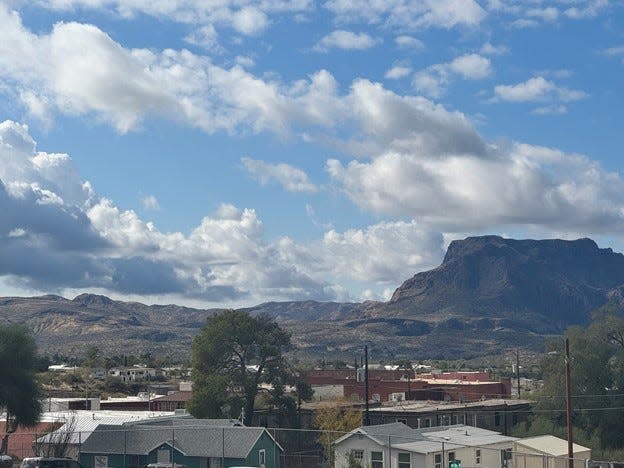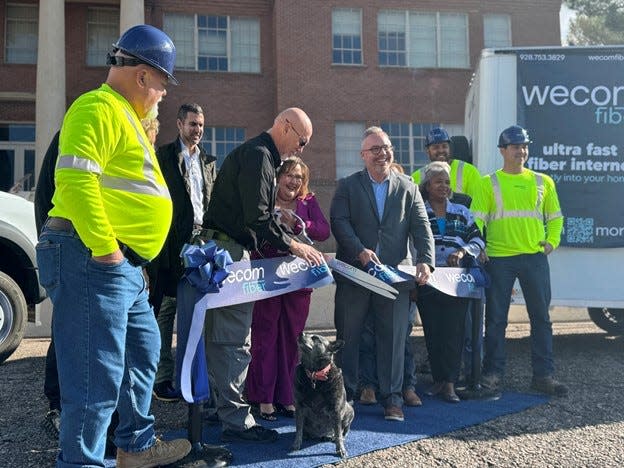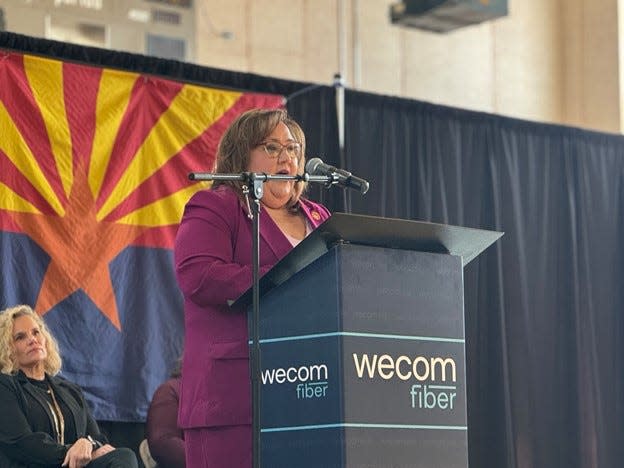'It can literally save lives': Pinal County poised for major broadband expansion

An internet service company plans to bring a fiber optic network to a vast swath of eastern Pinal County, a move that could help chip away at digital inequities and revitalize Arizona's copper corridor.
The first phase of the project by telecommunications company WeCom will connect community hubs in Superior. Its public library, Police Department and Fire Department are among those slated for fiber optic hookups in the coming months. WeCom CEO Paul Fleming said the pilot will cost $350,000, which will be entirely fronted by his company.
Superior, located in the northeastern tip of the county, is home to roughly 2,500 people and is a gateway to the copper corridor. Officials hope to gain access to state money next year that could help fund expansion of the network to homes and businesses in the town and other eastern Pinal County municipalities, including Kearny, Winkelman and Mammoth.
It could be a huge step toward increased connectivity in the area, which has a rich history of mining but has long struggled with a dwindling population and a lack of economic opportunities.
It could also serve as a launch point for expanding broadband to Gila County and other nearby areas in the years to come. WeCom is already building fiber optic networks in other rural areas of the state, including a $54 million project that will connect more than 30,000 Arizonans across Mohave County, La Paz County and the Hualapai Reservation.
"We want to be a shining star for what rural communities in Arizona can do," said Superior Mayor Mila Besich.
Officials have long sought to diversify local economies by highlighting municipalities' tourism and recreation potential. Superior, for instance, was awarded a state tourism grant for its annual Mining Festival and Burro Run in 2021 and put a portion of its federal COVID-19 recovery dollars into a tourism promotion program.
But local officials say the area cannot realize its full potential without connectivity. Meanwhile, residents can't access telehealth, online postsecondary courses and other crucial online services.
"The people who choose to live here, they have every right to have the same services as people in metropolitan areas," said Pinal County Supervisor Jeff Serdy, who represents Superior and the northern half of the copper corridor.
Rural Arizona's connectivity woes

Crystal Carrasco wasn't surprised to see she was offline while working the counter at Mountainside Coffee in Superior on Friday morning.
Carrasco said the small espresso outpost, located in the heart of Superior's historic downtown, runs into connectivity problems whenever the weather is bad. It rained hard the night before, she said.
As a workaround, the coffee shop's payment terminal saves encrypted credit and debit card information so it can be transmitted once connectivity is restored. But Carrasco still thinks her town should have better internet options.
Carrasco is one of the estimated 318,000 Arizonans who are unserved or underserved by internet.
The Federal Communications Commission currently defines connectivity as having minimum download speeds of 25 megabits per second of data. That's fast enough for a single user to watch a Netflix video in ultra high-definition or participate in a Zoom call.
People who are unserved don't reliably have access to connections of that speed. People who are underserved may have that minimum connectivity, but don't have high-speed internet, which starts at download speeds of 100 megabits per second of data. At those speeds, a small household can stream and telecommute with multiple users at the same time.
Most unserved and underserved Arizonans live in rural or tribal communities, according to an August broadband report from the Arizona Commerce Authority. The northwest corner and eastern half of the state are particularly hard hit.
Those areas are sparsely populated, making it less cost-effective to build a fiber optic network, Fleming said. In a dense area, his company could build a quarter-mile of fiber and pass more than 100 households that might pay for internet service. In rural places, it could take 10 miles of fiber just to hit a handful of customers.

Rural areas are also unlikely to have infrastructure or geography that makes fiber lines easy to lay. Many contend with geographic barriers, like the mineral-rich mountains that surround Superior and serve as the lifeblood of the town's mining industry.
"I have substantially less customers to sell into, and I'm spending more money. So the business case just doesn't work well there, to just say, 'Hey, I want to go out to a rural area and I'm going to just build all brand-new fiber everywhere.'"
'It helps everything': Officials say high-speed internet is crucial for area residents
When Besich moved home to Superior in 2007, she said local businesses were just starting to accept debit and credit cards.
"We've come a long way," she said.
But there are still gaps. About a third of the town's population is over the age of 65, according to the U.S. Census Bureau. The nearest hospital is 30 minutes away, and most people have to commute to the Phoenix metro to see specialty doctors. Reliable broadband could open up telehealth options for aging community members.
Most Superior residents don't have a college degree, according to Census Bureau data. Central Arizona College has campuses in the eastern half of Pinal County, and neighboring Gila County offers an Eastern Arizona College satellite campus. But all of those campuses are at least a 30 minute drive one-way for Superior residents. High-speed internet could change that.
Connectivity could also make Superior a more attractive spot for tourists and recreationalists who are seeking cooler summer temperatures and small town charm.
"Every step along the way — from students, to business, to tourism, to public safety — it helps everything," Serdy said. "It can literally save lives."
Fleming estimates it could take up to $150 million to cover all of the unserved or underserved pockets of Pinal County. Despite the cost, he sees opportunities to work the state and other government entities to bring high-speed internet to the region.
"We really want to bring service to locations that don't have anything and start to give them that same service that you can get in Phoenix or Las Vegas," Fleming said. "It's really a critical infrastructure item."
If government officials are willing to help subsidize the initial costs of laying new fiber, Fleming said his company is willing to pitch in and can keep rates reasonable. WeCom plans start at $70 per month for speeds of 500 megabits per second of data, Fleming said, and go up to $135 per month for 2,500 megabits per second of data.
That's on par with most other internet providers already in the area, Carrasco said. HughesNet and Viasat plans in Superior both start around $50 per month but generally go up after new customer promotions end.
WeCom also participates in the federal Affordable Connectivity Program, which offers discounts on internet bills for low-income households.
Besich said her town has to keep up with an increasingly online world. She hopes other rural communities will come to the table to "make sure every square mile of our state is covered."
"Long term, internet is going to be needed," she said.
Sasha Hupka covers county government and regional issues for The Arizona Republic. Do you have a tip? Reach her at sasha.hupka@arizonarepublic.com. Follow her on X, formerly Twitter: @SashaHupka. Follow her on Instagram or Threads: @sashahupkasnaps.
This article originally appeared on Arizona Republic: Company plans to bring fiber internet to Arizona's copper corridor
